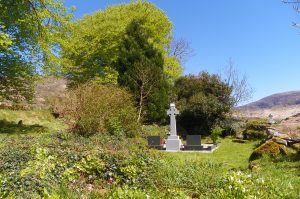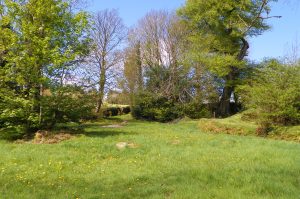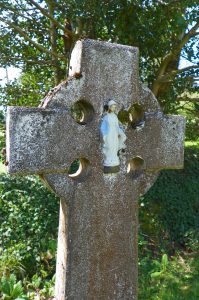St. Feaghna’s Graveyard


St Feaghna’s Graveyard is serenely situated on the infamous Priest’s Leap route, on a country road that climbs up to the Shehy Mountain Range. In his early ministry, the saint built a church known as ‘Teampall Feaghna’, now thought to be the most ancient ecclesiastical site in the parish of Bonane. It dates back to the 6th century AD.
John O’Donovan’s Ordnance Survey Letters written in the 1830s include this description: “In the townland of Garraun in the Kerry portion of the parish is a small portion of the ruins of an old church of St Fiachna’s called in Irish Teampall Fiachna. It was forty four feet ten inches in length and nineteen feet ten inches in breadth, and its walls were three feet thick and built of very large green stones cemented with line and sand mortar. All its walls are now destroyed to the foundations except the north half of the east gable and six feet of the north wall connected to the gable. This fragment of the north wall is eight feet high and three feet thick and looks very ancient. No doorway or window remaining.”
To this day, pilgrims visit Teampall Feaghna to perform a ritual known as ‘The Rounds’, involving prayers at various points along a designated pathway leading around the church ruins. A detailed description of The Rounds at Feaghna’s is given in the excellent book entitled ‘Bonane – A Centenary Celebration’, edited by Fr John Shine.
Surrounding these ancient ruins, the graveyard known locally as ‘Drom Feaghna’ has slowly emerged over the centuries. It almost certainly dates back to early Christian times. It is one of the oldest Christian burial sites still in use in Ireland which makes for an interesting mix of very old and very new gravestones side by side. Francis Joseph Bigger’s paper of 1898 was published in the Journal of the Royal Society of Antiquaries in Ireland and states: “…the churchyard is still a favourite place of burial,… Two in particular of the tombstones in the churchyard bear remarkable sculptures; both are O’Shea graves, bearing the dates 1815 and 1816. The mixture of the secular and the sacred elements in the larger one is very remarkable. I consider them both excellent examples, although debased, of the survival of the ancient Irish custom of blending symbolically the particular characteristics of deceased or his family with the most sacred symbols of his religion.”

The graveyard consists of an inner and an outer wall. The outer wall was constructed as a funded relief project for local workers during the time of the Great Famine in the 1840s. The inner wall or embankment, also in evidence today, is a much older structure. The ground between these two walls is known as ‘cillíní’, an unconsecrated burial place for unbaptised or stillborn babies and those who died by suicide. Some grave markers can still be seen there today.
A wooden viewing platform adjacent the southern outer wall of the graveyard allows the visitor to glimpse the Rolls of Butter on neighbouring farmland.
Visitors to St Feaghna’s Graveyard are asked to respect that this is not a tourist attraction but our community’s burial ground. Whilst you are welcome to visit, please do not litter or interfere with the graves in any manner whatsoever. Parents are asked to keep an eye on their children – this is not a playground.
(Sources: Bonane – A Centenary Celebration, Edited by Fr John Shine; A Guide to the Sheen Valley Heritage Area, by Bonane Community Council)


